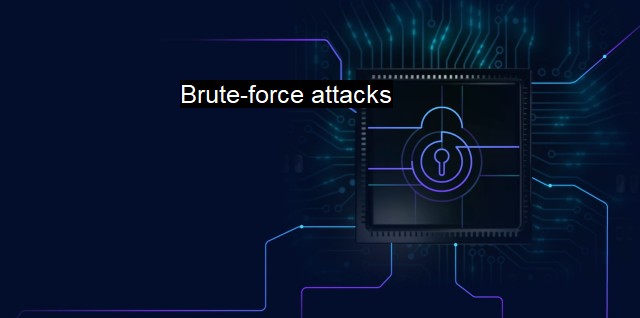What are Brute-force attacks?
Uncovering the Darkness: Unveiling the Devastating Threat of Brute-Force Attacks in Cybersecurity and Techniques Used by Cybercriminals to Invade Systems
A brute-force attack is a method used by cybercriminals to gain access to a private network, system, or service. This type of attack is the equivalent of a physical thief taking on the task of trying to find the right key on a large keyring to open a door. Just as the thief would systematically check each key until finding the right one, in a brute-force attack, the hacker tries all possible combinations of passwords until they hit upon the correct one. This method is called 'brute force' because it relies on the pure computational power and persistence of the attack, rather than any inherent weakness in the system itself.Although the brute-force method is primitive by hacking standards, it can be particularly effective against systems with weak password control measures, especially where the passwords involve any fundamental structure, such as strings of consecutive numbers or letters. The method is increasingly being employed by attackers due to the availability of advanced software and cheap computing power both of which make the brute-force technique more potent.
Brute-force attacks can take on two main forms: purist and dictionary-based. The purist version, also known as exhaustive key search, involves testing all possible combinations until the password is discovered. The dictionary-based form takes a slightly more streamlined approach by using a list of likely passwords, words from the dictionary, or its own database of commonly used passwords.
The damage that can be inflicted by a successful brute-force attack makes it an essential cybersecurity concern. If an intruder gains unauthorized access to a system, they may obtain sensitive personal or business information, social security numbers, bank details, intellectual property, and more. Plus, hackers can modify data, execute functions, or even take over the entirety of a system's operations.
Antivirus software provides some level of protection against brute-force attacks, commonly by identifying and blocking traffic that fits the pattern of a brute-force attempt. It may do this by flagging numerous failed login attempts from the same IP range or identifying usual, non-human patterns of behavior.
There are other even more specific solutions to protect against brute-force attacks. One of them is password complexity. Incorporating a password policy that requires users to create complex, lengthy passwords using a mix of numbers, characters, and symbols can provide greater resistance against brute attacks. This is because the computational time and resources required to brute-force a long and complex password are exponentially higher. Other methods could involve a policy that locks a user account or even blocks an IP address following consecutive failed login attempts.
Two-factor authentication (2FA) has also become a widespread solution to protect against brute-force and other types of attacks. As the name suggests, 2FA requires a user to provide two or more pieces of evidence (or factors) to authenticate their identity.
Captcha is another tool used to prevent brute force attacks. By incorporating simple puzzles or photographic identification tasks into login procedures, websites can verify that a legitimate human user, rather than an automated script, is attempting to gain access.
While Antivirus software is an excellent basic defense, experts usually recommend a toolkit of security solutions including regular password changes, additional barriers to login attempts, and professional IT support monitoring. Only by combining these multiple layers of defense can organizations expect to protect against a technique as disturbingly straightforward and all too prevalent in today's digital landscape such as the brute-force attack.
a brute-force attack is a primitive yet often successful hacking method that systematically tries all possible password combinations to gain unauthorized access to a system. While antivirus software provides some level of protection, the best defense incorporates multiple tactics. This would include complex and lengthy password requirements, captchas, two-factor authentication, and monitoring by security professionals. The potential damage falling to a successful brute force attack underlines the seriousness of maintaining a solid defense strategy in the evolving climate of cyber threats.

Brute-force attacks FAQs
What are brute-force attacks in cybersecurity?
Brute-force attacks are malicious attempts to crack password-protected systems through trial-and-error methods. Cybercriminals use automated tools to repeatedly enter various combinations of passwords until they guess the correct password and gain access to the system.What are the potential risks of a brute-force attack?
Brute-force attacks can lead to data breaches, identity theft, and financial losses. Attackers can steal sensitive information, install malware, or hijack user accounts.How can antivirus software protect against brute-force attacks?
Antivirus software can detect and block brute-force attack attempts by analyzing network traffic and identifying suspicious patterns. It can also alert users when their accounts have been compromised by a brute-force attack.What measures can individuals and organizations take to prevent brute-force attacks?
Individuals and organizations can prevent brute-force attacks by using strong passwords, changing them regularly, and enabling two-factor authentication. It is also important to keep antivirus software up-to-date and limit access to sensitive data to authorized personnel only.| | A | | | B | | | C | | | D | | | E | | | F | | | G | | | H | | | I | | | J | | | K | | | L | | | M | |
| | N | | | O | | | P | | | Q | | | R | | | S | | | T | | | U | | | V | | | W | | | X | | | Y | | | Z | |
| | 1 | | | 2 | | | 3 | | | 4 | | | 7 | | | 8 | | |||||||